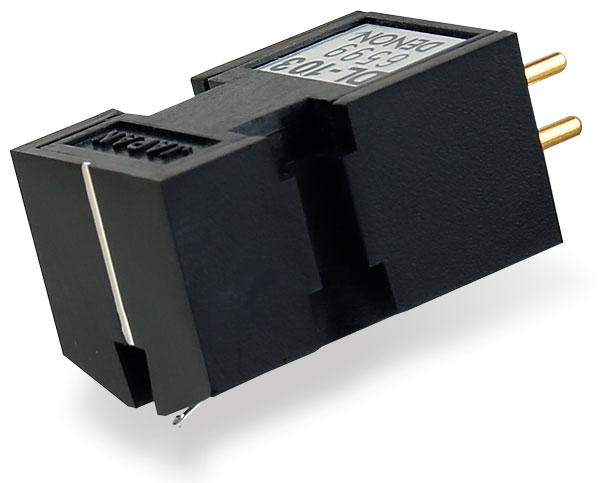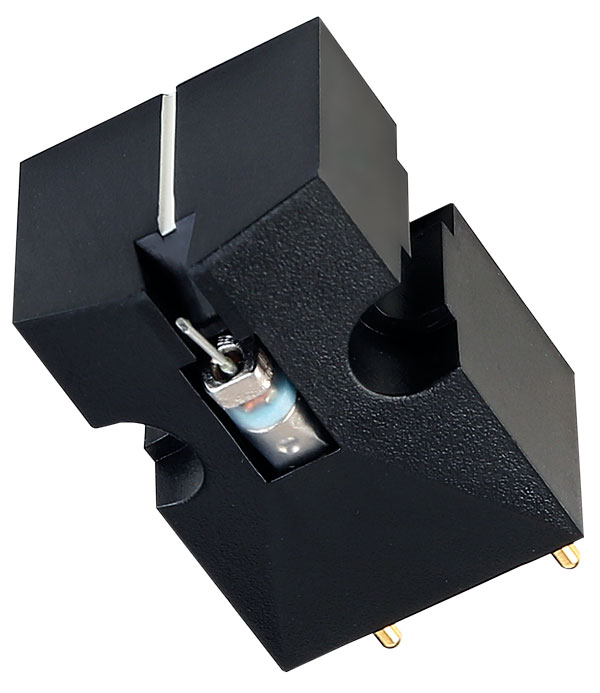Denon DL-A110 Cartridge

 Still in production since 1964, and instantly recognisable to audiophiles across the globe, Denon's classic DL-103 moving-coil pick-up gets the Anniversary treatment
Still in production since 1964, and instantly recognisable to audiophiles across the globe, Denon's classic DL-103 moving-coil pick-up gets the Anniversary treatment
Don't let the model name confuse you if our pictures assault your memory bank: this £499 Denon DL-A110 phono cartridge is the best-selling, much-loved sexagenarian DL-103, only with a slick headshell and packaging plush enough for a wristwatch. This anniversary offering joins Denon's AVC-A110 AV amp, PMA-A110 integrated amplifier and DCD-A110 SACD player [HFN Dec '20], the quartet marking the company's first-century-plus-10. (Oddly, there's no record deck…)
For this special edition, and for the casual observer, the only thing changed is the presentation. Instead of a minimalist cardboard box and plastic case, the DL-A110 comes in a velvet-lined leather box, oozing luxury. Inside is the familiar low-output, 9g moving-coil classic – originally conceived for professional/FM broadcast use – with its aluminium cantilever, spherical stylus and the best-ever body for alignment.
Why doesn't every cartridge have a bold white line down the front to aid in setting azimuth, and slab sides for easy reading on a protractor? Of course, there are differences in performance with this latest model, not least a boost to output level, if for no other reason than materials (magnets) and running production changes have necessarily evolved over nearly 60 years.
In Hand
Allowing for celebratory license, Denon tells proud owners that this cartridge was 'meticulously hand-spun in the Denon Audio Works factory in Shirakawa, Japan just as it was in the 1960s… maintaining the original headshell design'. For the DL-A110 kit, this lightweight silver-graphite universal headshell is aimed at true anachrophiles, Denon safely assuming that these enthusiasts, especially in Japan, will be using arms equipped with the bayonet fitting first seen on Ortofon's SPU in 1958, and later adopted by myriad tonearm manufacturers.

Code Breaker
Ortofon eventually enabled its SPUs to work in fixed-headshell arms by releasing the shell-less N-suffix models, recovering business lost to customers who did not use Ortofon arms, Acos Lustres, SME 3009s/3012s, or others with the bayonet mount. But, despite the fact that the DL-A110 can be removed from the headshell, it remains a pain to connect and screw into place.
While I appreciate that the anniversary headshell here is a cool and desirable part of the package, I would posit that most modern vinyl users spending circa-£500 on an MC will own fixed-headshell tonearms. Flat Earthers converted the faithful a lifetime ago into accepting that no tonearm with a removable headshell could provide the same rigidity.
Regardless of that argument, I'm guessing there will be customers for this who will do what PM and I had to do to review it: remove it from the headshell. But disconnecting the cartridge leads reveals that Denon still does not colour-code its pins. Perhaps it assumes the majority will stay pre-fitted and pre-wired to the shell, so why bother? But hands up, those who have memorised the red/green/blue/white identification of ±L/R pins. And even if you do remember them, the back is hard to read if you lack macro vision.
Going Spare
If that wasn't enough to make me rue Denon's decision to leave the original DL-103 utterly untouched, there's worse. This will ring a bell with any retailer who sold a load of these back in the day – and the DL-103 was hugely successful. It's an inescapable fact that the slotted sides for the mounting screws are the absolute worst cartridge fixing set-up this side of the red plastic clip used by Deccas.

If using the DL-103 in DL-A110 guise as a pre-fitted item, this isn't an issue: the screws are perfect for it. Unfortunately, our sample (all samples?) didn't come with spare nuts-and-bolts for easy mounting in fixed headshell arms. Trust me: the space at the bottom of the cartridge body calls for long screws with tiny heads, or if using them with the screws going down through the tonearm slots, for equally tiny nuts.
Even if you have a bunch of them – I found some that worked, from another cartridge – you simply cannot tighten them to reasonable levels without deforming the DL-103's body. Having fitted dozens of DL-103s in my retail days, I knew the drill but it would have improved the experience if Denon had made the DL-A110 with colour-coded pins and closed, modern-diameter lugs.
For you purists shouting 'Heresy!', I don't see anyone complaining about other classics of pension age still on the market and which have been updated or refined with restraint: Klipschorns, the McIntosh MC275, London cartridges (née Deccas), the aforesaid Ortofon SPUs, etc. Rant over because, at a mere 57 years young, the Denon DL-103 remains an all-time great.
![]() Party Like It's 1964
Party Like It's 1964
Adding to the celebrations, for those who absolutely want the DL-A110 version to mimic the original, I compared the individual factory printouts for the newcomer with that for my vintage DL-103 – both undertaken with TRS-1005 test records, at 20oC and 2.5g downforce. And wow, were they close with near-superimposable response traces and claimed output levels that seem barely to have changed – 0.35-0.37mV for the oldie and 0.37-0.39mV for the DL-A110. In practice, and not unexpectedly, the DL-A110 reveals itself to be somewhat slicker.

























































